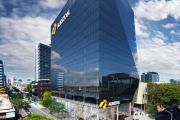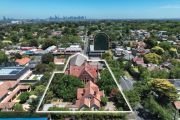
Inland Rail takes a step forward as freight hub plans unveiled
The multibillion dollar Inland Rail project has taken another step forward with the purchase of a sprawling plot of land to be used to build the largest shipping container freight terminal and logistics precinct in Australia.
National Intermodal, the federal government’s developer of critical logistics infrastructure, has acquired 1100 hectares at Beveridge, 40 kilometres north of the Melbourne CBD, where it will build the first of two major warehouse and rail terminal areas near the city.
They will hook up with Inland Rail to enable freight to be more easily moved from Victoria’s two largest ports of Melbourne and Geelong to the rest of Australia.
The Inland Rail, announced by the Turnbull government in 2017, was originally expected to cost $8.4 billion and slated for completion in 2025. However, a review by former Commonwealth energy adviser Kerry Schott, published in April found the project would cost at least $31.4 billion, with no end date in place. Only one section of the proposed 1700-kilometre rail line – from Beveridge to Parkes in Central West NSW is scheduled to be completed by 2027.

National Intermodal is also developing a site at Truganina, west of the city, while Aware Super is backing a third, privately funded $400 million terminal in Somerton, also in Melbourne’s northern suburbs.
The 2022-23 federal budget committed $3.1 billion for National Intermodal’s two Melbourne terminals, including $1.62 billion for the Beveridge development and $280 million for associated road connection upgrades. About $740 million has been earmarked for Truganina, and $920 million for the outer metropolitan ring south rail connection.
Subject to planning approvals, the Beveridge site – purchased for an undisclosed sum – could eventually become a supply chain logistics precinct twice the size of Moorebank, in Sydney, which is currently the largest in Australia. The Beveridge site will have capacity for 500,000, six-metre shipping containers.
The precinct is expected to open following the completion of stage one in 2024-25, and be fully operational by 2028-29.
Australia’s largest rail freight operator, Aurizon, has signed a memorandum of understanding to be the Beveridge hub’s foundation customer.
‘The development of intermodal precincts at Beveridge and Truganina will be genuinely transformational.’
National Intermodal chief executive James Baulderstone
The Beveridge site will be on the Tottenham to Albury section of Inland Rail, and see double-stacked containers for 1800-metre trains travelling to Perth via Parkes, as well as Brisbane, the proposed northern terminus of Inland Rail. It will also provide a more efficient rail connection into Moorebank.
Melbourne’s existing hub, which does not support double-stacked trains, will close after 2030.
National Intermodal chief executive James Baulderstone said the government’s support for a two-terminal strategy for Melbourne is a great opportunity for Victoria.
“The development of intermodal precincts at Beveridge and Truganina will be genuinely transformational,” he said. “The completion of this [land] transaction is the first step in making this vision a reality.” The Beveridge and Truganina developments, together with inland rail, “will revitalise the rail freight sector”, he said.
The Beveridge terminal will provide significant employment during construction, as well as acting as a catalyst for other local infrastructure investment, he said. “Once completed, this world-class logistics precinct will create thousands of highly skilled supply chain jobs,” Baulderstone said.
Mitchell Shire Council and the City of Whittlesea, Hume City Council, NorthLink, and the Northern Councils Alliance have already indicated their support for the Beveridge project, which they believe could support up to 20,000 jobs in the region.
National Intermodal purchased an option to acquire the Beveridge site from logistics company Qube. As part of that deal, Qube has an option to reacquire up to 200 hectares for its own use, separate to the proposed National Intermodal terminal.
Qube managing director Paul Digney said the terminal and inland rail were crucial to the creation of better linkages to national and global markets.
“The expansion of Australia’s freight infrastructure is critical to supporting economic growth, and moving more freight on rail will help reduce road congestion and contribute to reducing emissions in the transport sector,” he said.
Digney said Qube would assess the opportunity for investment at Beveridge as part of its broader intermodal rail strategy. No significant investment is expected in the short to medium term, he said.











